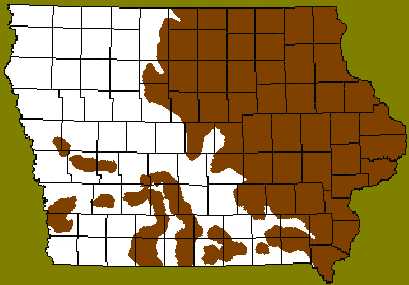Karst is a term used to describe terrain that is composed of, and/or underlain with, carbonate rocks (such as limestone) that have been altered to create caves, caverns, sinkholes, and underground streams. Karst conditions occur when water and carbon-dioxide from the air and soil combine to create a mild carbonic acid. This mild acid then mixes with groundwater and enters the carbonate rocks through cracks, splits, and small fissures, where it slowly dissolves the rock to create openings. Eventually these openings enlarge enough to create cavern systems that can have complex links back to the surface.
The areas shaded brown on the map below indicate karst topography within the state of Iowa.

This map was adapated from the US Geological Survey's National Karst Map
Project and does not differentiate between karst, paleokarst, or pseudo-karst, nor does it
indicate depth under sediment. This map should not be considered 100% accurate.
Conditions favorable for karst formation have occurred in Iowa periodically throughout its geologic past, most notably during the Ordovician, Devonian, Mississippian and Pennsylvanian periods some 470 to 315 million years ago. These ancient karst areas have features similar to modern day karst, but have been buried under soil and younger geologic formations. In addition to these ancient formations, karst processes are still active in some parts of the state today (Source: Iowa Geology 1996, No. 21, Iowa Department of Natural Resources).
For a more comprehensive introduction to Iowa's karst the Iowa Grotto has provided a copy of the chapter reviewing Iowa from the National Speleological Society's book Caves and Karst of the USA on this website. Please note that this chapter is copyrighted material and can not be redistributed or reproduced without the express written consent of the National Speleological Society. Direct links to this chapter from outside websites are also strictly forbidden by the Iowa Grotto. To view this chapter in your web browser please click here – Chapter 4: Glaciated Central Lowlands – Iowa


